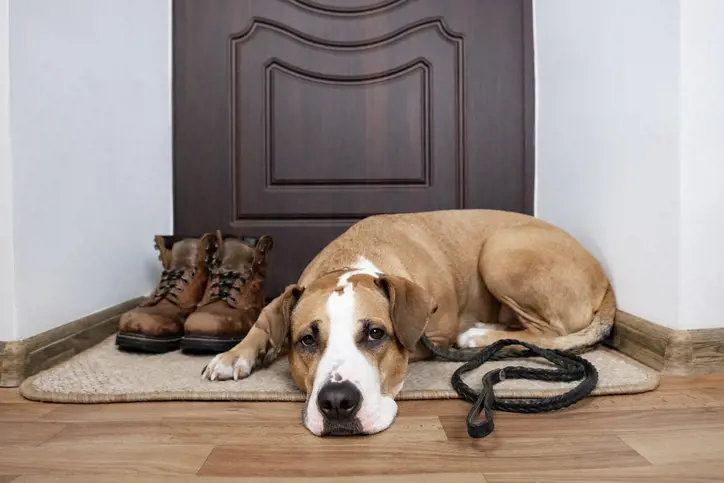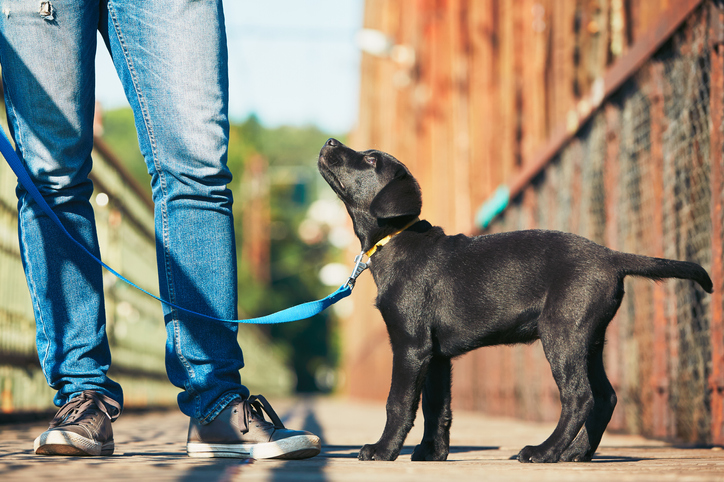What is luxating patella in dogs?
24th November, 2021

Luxating patella is one of the most common orthopaedic conditions of dogs, diagnosed in more than one in 20 puppies. It is a condition which affects primarily small dogs, particularly breeds such as Boston and Yorkshire Terriers, Chihuahuas, Pomeranians, and Miniature Poodles. However, an increasing number of large breed dogs such as the Chinese Shar Pei are found to be predisposed to the disease.
Clearly, luxating patella is a condition that dog owners need to know about. And if you’re an owner of one of the breeds which is genetically predisposed to the condition, you’ll want to make sure that you’re covered by your dog insurance policy should your beloved pup need any emergency or on-going treatment.
With luxating patella affecting both knees in half of all cases, it can cost a pretty penny to treat. But is there anything that can be done to protect your dog against the condition? In this article, we’ll answer that question, plus a host of others – starting with…

What is it?
If you know your human biology, you’ll know that patella means kneecap. Dog kneecaps are not as pronounced as human ones, but they all have them. Your dog’s almond-shaped patella – plus its tendon – works in sync with the quadriceps muscle, gliding up and down a groove at the front of the knee joint.
However, should the patella come out of its normal groove, your dog will not be able to move or extend their knee properly – this is called luxating patella. As you might expect, this can cause your dog to limp or have an abnormal gait. It can be painful for them, but how much depends on the severity of the dislocation.
If not spotted or left untreated for any length or time, your dog’s tibia will start to rotate differently from the femur, putting a stress on the cranial cruciate ligament. In such cases of luxating patella, the cruciate ligament is often also damaged, which can add further complications to treatment of the condition.
Due to the problem often being down to a dog’s genetic make-up, around half of canines with luxating patella have it in both knees.
What causes it?
As we’ve already hinted at, most of the time, luxating patella is due to genetic issues. For some breeds, the kneecap groove is too shallow, and it doesn’t take much for it to pop out.
Luxating patella might also be down to a skeletal defect, such as abnormal hip joint or tight/atrophied quadriceps muscles.
Patella luxation can also be caused by an accident which has caused the knee joint to pop out of its natural position. Or simply, over-exertion can cause the patella to slip out of its groove, which requires treatment to realign it.
In a study of 124 dogs with luxating patella, it was found that 82% of dogs had congenital luxation – 98% of which were small breeds.
While we’re not here to put you off buying a smaller dog, the figures act as a reminder that you should always do your research before picking the perfect pup for you and your circumstances.

Make sure you buy a puppy responsibly
Now is a good point to remind you to do your utmost to ensure you only buy puppies from reputable breeders. As our article on the topic explains, you need to put in the research to make sure you don’t end up with a puppy that has a host of health issues.
With luxating patella in mind, you might want to ask to see the medical records on the puppy’s parents to see if there is any history of the condition – any reputable breeder will only be too happy to provide them, and answer any other questions you might have.
Luxating patella often shows itself at an early age, so make sure you are given the opportunity to observe the puppy in question to see its gait before you part with any money.
What are the signs of luxating patella?
We’ve already touched on some of the visual symptoms of luxating patella. But the most obvious sign to look out for is an intermittent hopping/ skipping – it might only last a couple of seconds but it suggests the patella is slipping in and out of the groove.
If both legs are affected, your dog might do a ‘bunny hop’ or drag their legs. Other signs of the condition include a general stiffness in the back legs.
If you spot any of these signs, you will need to book in to see your vet right away. During an examination, your vet may try to manipulate the patella in and out of place. If they can, it’s clear there’s a problem. If it’s less clear, X-rays may be required to assess the knee joint in more detail.
How is luxating patella treated?
Treatment of luxating patella is dictated by the severity of the condition. Hill’s explains that luxating patella is graded based on severity. Here’s what each grade means:
-
Grade I: The kneecap comes out of its normal position when manipulated but slips back in once the pressure has been released. Grade 1 might not be causing the dog any pain and clinical symptoms are usually sparse – it’s often found incidentally on examination by a vet.
-
Grade 2: The kneecap comes out of its normal position when manipulated and remains displaced until realigned manually. Symptoms are visible intermittently when the patella luxates out of its normal position, which can be painful for the dog and cause cartilage damage.
-
Grade 3: The kneecap keeps coming out of position but can be manually realigned by a vet. Dogs at this grade will usually exhibit more lameness and experience more pain.
-
Grade 4: The kneecap is permanently dislocated and cannot be ‘fixed’ with manual pressure. The structure of the limb will usually be changed, leading to profound lameness and impaired mobility.
Once your vet has determined what grade your dog’s luxating patella is, treatment options will be discussed. For Grades II to IV, surgery will usually be the only option. But, if your dog has Grade I luxating patella, they might be able to get away without going under the knife.
We’ll discuss the lengths you can go to avoid surgery in the next section, but let’s first look at the different types of surgery:
-
Tibial tuberosity transposition
This surgery involves realigning the tendon between the kneecap and shin bone. The bone will be cut to move it into a better position, which will typically take four to eight weeks to heal. Sometimes, the shin is secured with wire and/or pins in order to balance the pull of the quadriceps muscle in the opposite direction.
-
Femoral varus osteotomy
If your dog is suffering from a severely bowed femur, this surgery will straighten their shin bone. This is done by removing a wedge of bone and repairing the femur with a plate and screws. This procedure is usually saved for larger dogs or patients with high-grade luxation. A CT scan will be required prior to surgery.
-
Recession sulcoplasty
If the problem is caused by a shallow groove, meaning the patella often comes out of position, this surgery will rectify with the removal of a wedge or block of cartilage and bone, giving it a more recessed position.
-
Soft tissue reconstruction
It’s often the case for dogs with luxating patella that the soft tissues on either side of the kneecap are too tight or too loose. Reconstruction will ease tight tissues and stiffen loose tissues.
What does recovery look like?
Recovery from luxating patella surgery can take three months – but it depends on the severity of the condition and extent of the procedure.
Generally speaking, for all dogs that have undergone surgery, in the first couple of weeks, they will need to take it easy.
Activity should be restricted to the bare minimum, with no access to stairs or steps. The most effective way of limiting a dog’s exercise is to keep them confined to a crate or closed-off area of the house. However, we know this can be tricky if they’re not used to it staying sat down in one place!
In weeks three to six, you can usually let your dog roam the house again – but walks might still be off limits. After six weeks, you will be invited back to the vets to see how your dog is progressing after surgery. The new X-rays will determine whether you can get back to taking your dog out for a walk or wait another couple of weeks.
If dog walks are a possibility again, you might be encouraged to keep them on the lead. But your vet is the best person to guide you through your dog’s recovery.
Unfortunately, recovery from luxating patella isn’t always smooth sailing. One study suggests that as many as 37% of dogs who have medial patellar luxation surgery go on to experience complications, such as recession wedge displacement and wound reopening.
To minimise the chances of your dog experiencing complications, you should take a cautious approach – literally don’t let your dog run before they can walk!
Luxating patella surgery often costs thousands of pounds, and you don’t want to have to keep going back to the vets with the same condition. Once you reach the benefit limit on your dog insurance policy, you won’t be able to keep claiming for the condition.

What can you do to avoid surgery?
If your dog has a Grade 1 luxating patella, you might be able to manage the condition without surgery. Diet and exercise are key.
In terms of nutrition, you want to ensure your dog gets foods which naturally promote healthy, functional connective tissue and control inflammation and pain.
A healthy diet also makes it easy for your dog to maintain a healthy weight. Excess weight puts pressure on your dog’s joints and hinders their mobility. While we all like to treat our pups, you might be doing them more harm than good if you overdo it.
Your dog can exercise normally with Grade 1 luxating patella. In fact, it’ll help keep their muscles and tendons strong – which will then provide better support to their joints. However, if your dog is used to long walks, you might want to pare them back a bit. Also, if you know your dog gets over excited in certain circumstances – when another dog is on the scene, for instance – you might want to restrain them so they don’t do themselves any damage.
Getting your pet in shape
If your vet suggests that your dog could do with shedding a few pounds, we have written a guide on doing exactly that. As a way of a summary, here are seven ways to stop your pet from becoming overweight:
-
Know their weight – regular weigh-ins and body checks are essential. Sometimes it can be hard to see if your dog is putting on the pounds, especially if they have thick fur. By tracking the weight, you have a better idea of how your pup compares to the recommended weight for your breed of pet.
-
Avoid leftovers – it’s hard to track the calories from scraps and leftovers.
-
Feed healthy treats in moderation – ignore the pleading eyes and make them earn those treats.
-
Control their diet – make sure their diet is appropriate for their age and breed.
-
Take it slow and steady – don’t put your dog on any kind of crash diet because restricting food can lead to serious health and behavioural issues.
-
Keep your pet active – exercise is not only good for your dog’s waistline; it also acts as valuable bonding time.
-
Make a regular trip to the vet – your vet will usually let you know in no uncertain terms if your dog needs to lose some weight.
Dog insurance for a wide range of breeds
Unfortunately, some breeds of dog are more susceptible to conditions like luxating patella than others. Here at Purely Pets, we don’t discriminate. We have a dog insurance policy for most dog breeds, which will add some financial protection should they need any kind of treatment they require.
Our Gold products have been awarded a coveted 5* Defaqto rating for 2021. Cover also comes with access to an online policy management portal so you can manage your cover at any time.
Get a quote for dog and puppy insurance today.
Helpful Pages
Recent Posts
Pet Insurance Quote
- 98% claims paid *
- Claims paid directly to vets
- 24/7 vet video consultations
- Interest free monthly payments




